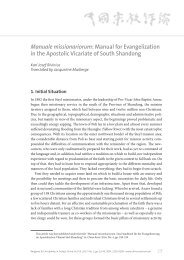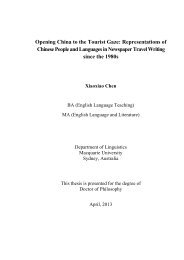EDUCATION IN CHINA
Education-in-China-a-snapshot
Education-in-China-a-snapshot
Create successful ePaper yourself
Turn your PDF publications into a flip-book with our unique Google optimized e-Paper software.
Chapter 1 – Organisation and management of education in China<br />
FIGURE 1.4 SHARE OF EXPENDITURE ON <strong>EDUCATION</strong> BY SOURCE OF FUND<strong>IN</strong>G (2014)<br />
2.28%<br />
0.24% 16.54%<br />
0.40%<br />
Government appropriation for education<br />
Funds invested by private school founders<br />
80.54%<br />
Donations and fundraising<br />
Institutional income<br />
Other funds<br />
Source: National Bureau of Statistics (2014), China Statistical Yearbook, www.stats.gov.cn/tjsj/ndsj/2014/indexeh.htm.<br />
China’s educational appropriations reflect the fact that<br />
education is a national priority. The country has focused<br />
significant resources on improving education quality<br />
and reducing inequalities in recent years. Currently,<br />
the Ministry of Education has set four areas of priority:<br />
1) rural, remote, poor and minority areas; 2) primary<br />
education in rural areas, vocational education and preschool<br />
education; 3) subsidies for students from poor<br />
families; and 4) building a high-quality team of teachers.<br />
China has emphasised the supervision of educational<br />
funds in official documents in recent years. The<br />
government has stated that it aims to develop a more<br />
public and comprehensive supervision system for<br />
education funding. This would consist of a regular and<br />
standardised system for supervision. Such a system<br />
would mandate the supervision of schools and relevant<br />
organisations by education administration departments,<br />
and the monitoring of administration departments<br />
themselves by the public.<br />
Educational administration departments at all levels are<br />
required to strengthen their supervision of schools and<br />
organisations through financial evaluation, internal audit<br />
and special inspections. Subsequently, the inspection<br />
results are to be put into effective use. All administration<br />
departments are expected to link inspection results<br />
to performance appraisals and resource allocations.<br />
In this way, the government hopes to make real use<br />
of the inspection system by building a standardised<br />
management system.<br />
All administration departments are expected to submit<br />
their budgets and final accounts, as well as public<br />
funds and administration expenses, to public scrutiny.<br />
Universities that are directly affiliated with the Ministry<br />
of Education are also required to demonstrate financial<br />
transparency.<br />
Box 1.6 Education funding<br />
The education system in China is funded by a number of<br />
sources. Government appropriations are the major source<br />
of funding. Government appropriations are comprised of<br />
budgetary and non-budgetary funds, of which budgetary<br />
funds are the main component. Budgetary funds, or public<br />
expenditure on education, include funds from both the<br />
education sector and other sectors. Non-budgetary funds<br />
include taxes for education levied by local government,<br />
educational funds from enterprises and other funds that<br />
belong to government appropriations. Additional financial<br />
sources for education include tuition fees, donations and<br />
fundraising.<br />
Other than government appropriation for education,<br />
private organisations and individuals are the principal<br />
sources of funding for schools run by these organisations<br />
or individuals.<br />
Source: National Bureau of Statistics (2014), China Statistical Yearbook, www.stats.gov.cn/tjsj/ndsj/2014/indexeh.htm.<br />
16 – <strong>EDUCATION</strong> <strong>IN</strong> CH<strong>IN</strong>A: A SNAPSHOT © OECD 2016





